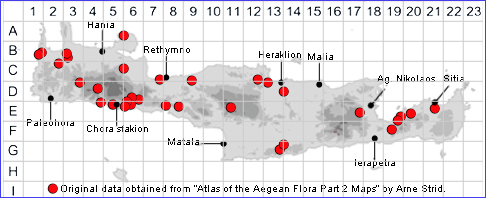
ERYSIMUM CANDICUM subsp. CANDICUM
Family and Genus:- See- CRUCIFERAE
Common Names:- None
Homotypic Synonyms:- None
Meaning:- Erysimum (Gr) A name used by the Greek philosopher Theophrastus
(perinnial wallflowers).
Candicum (L) From Crete, Cretan.
Plant:- Small shrub 25-50 cm.
Stems:-
1) Erect; simple or branched up to 30 cm in flower, up to 60 cm in fruit; hairs divided
at the tip in 2(-4) (usually equal) parts by a median cleft (2(-4)-fid).
Leaves:-
1) 20-120 x 3-13 mm, entire or with a few serrations, densely pubescent.
2) Petiole, much shorter than the lamina.
Flower:-
1) Raceme, of fragrant yellow flowers. The racemes elongate considerably during
fruit development.
2) Sepals, 6-8 mm.
3) Petals, 11-17 x 3-5·5 mm, pubescent on the back.
4) Style, 2-4 mm.
Fruit:-
1) Siliqua, 20-60 x 4-4·5 mm, somewhat compressed with a thin mid-vein on each
valve.
2) Seeds, 5-6 x 3.5 mm. in 1 row in each loculus.
Key features:-
1) Petals, 13-22 x 5-8·5 mm.
2) Siliqua, ± terete, with a weak mid-vein on each valve.
Habitat:- Crevices of limestone cliffs, usually in semi-shade in gorges, (not on
maritime cliffs). 50-700(-1000) m.
Distribution:- Endemic to Crete. Limited distribution.
Flowering time:- Mar-Apr.
Photos by:- Fotis Samaritakis & Zacharias Angourakis
Status:-
Conservation status (for threatened species): Near Threatened (nt) according to
IUCN 1997
Protection status (for threatened species): Greek Presidential Decree 67/1981
SPECIES DESCRIPTION
